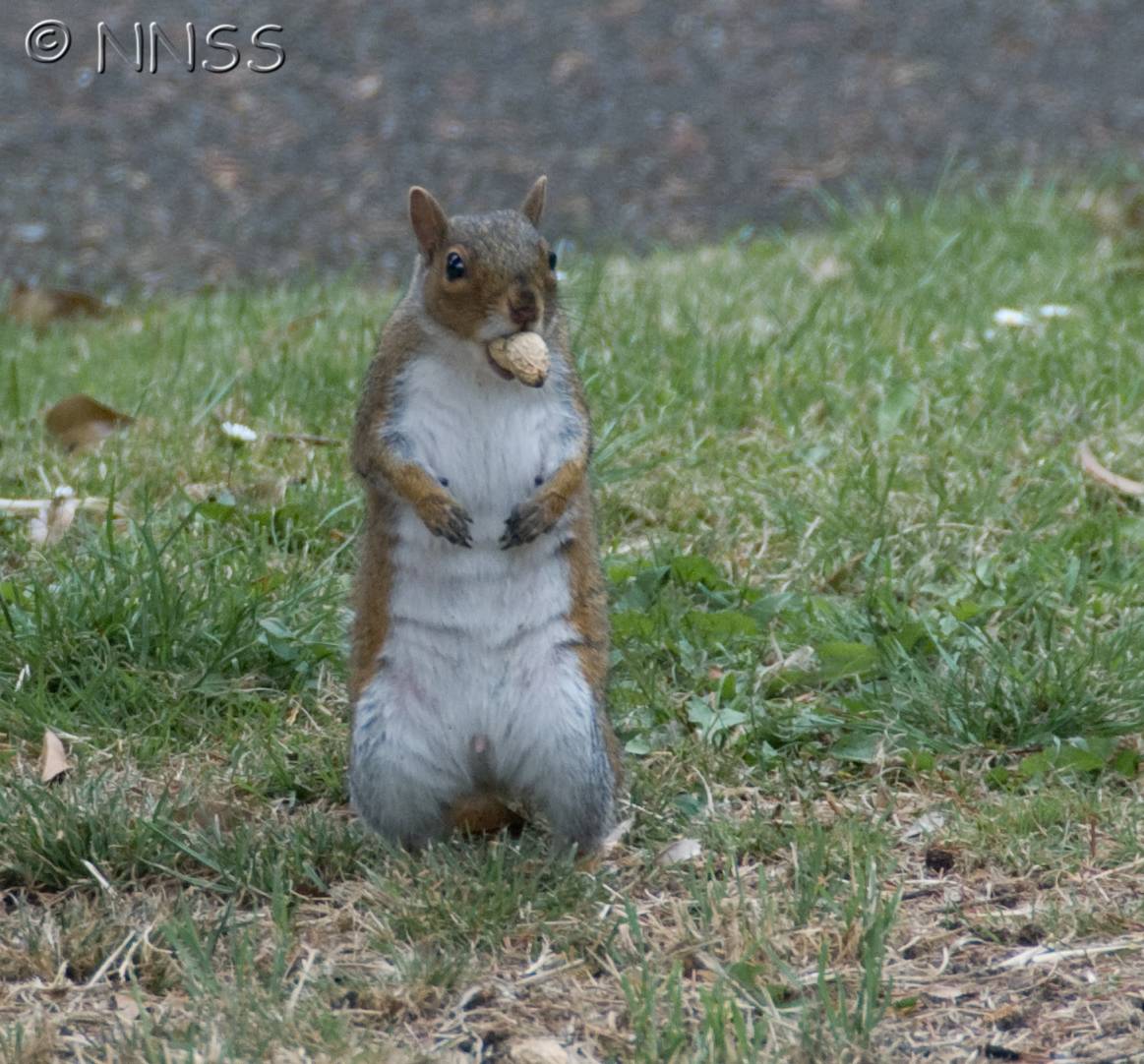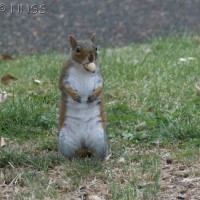
Grey Squirrel - Sciurus carolinensis
Expand and collapse the sections below by clicking on the title or + / - icons.
Short description of Sciurus carolinensis, Grey Squirrel
Grey squirrels are mainly grey on both body and tail, but some areas of fur may be more gingery-brown. The underside of the body is white. They constantly twitch their long tails, which are abundantly fringed with long, straight, black-and-white-tipped hairs. Black morphs occur in some parts of the range.
Impact summary: Sciurus carolinensis, Grey Squirrel
Grey squirrels have displaced native red squirrels from much of their former GB range. Grey squirrels damage trees by gnawing young bark, causing commercial damage to forestry and nuisance to gardeners. Grey squirrels are predators of birds’ eggs and chicks.
Habitat summary: Sciurus carolinensis, Grey Squirrel
Grey squirrels occur in all woodland, but are most abundant in mature deciduous woods; they also occur in open habitats (e.g. gardens, farmland) where trees are present. They readily cross open areas without trees, but hesitate to cross open water.
Overview table
| Environment | Terrestrial |
|---|---|
| Species status | Non-Native |
| Native range | Eastern United States, Far East United States, South East Canada 1, South East Canada 2 |
| Functional type | Omnivore |
| Status in England | Non-Native |
| Status in Scotland | Non-Native |
| Status in Wales | Non-Native |
| Location of first record | Llandisilio Hall |
| Date of first record | 1828 |
Origin
This species is native to the eastern part of North America, from Texas and Florida northwards to Saskatchewan and southwestern Quebec and is also called the eastern grey squirrel. There is also a western grey squirrel S. griseus, native to the western USA.
First Record
The first recorded occurrence in GB was at Llantysilio Hall in Denbighshire in October 1828. In 1938 it was declared illegal to import grey squirrels into GB or keep them in captivity, but by this time the species was well established and spreading rapidly in many parts of GB.
Pathway and Method
There were multiple introductions and naturalisation attempts made in GB between 1876 and 1929. These were highly successful. On several occasions populations originated from the release of fewer than ten individuals.
Species Status
Constantly expanding in GB, Ireland and in Italy. Introduced in three different localities of northern Italy from 1948 to 1994, it is established in a large portion of Piedmont, along the Ticino valley and in an urban park in Genoa. It is expected to colonise France and Switzerland in the next few decades and may eventually invade a large portion of Eurasia. Density is usually below 3 individualsha (spring density in England 2.4–2.7), but higher in optimal habitats (18 ind.ha in an urban park in Italy; 3–18 ind.ha in an oak forest in GB).
Dispersal Mechanisms
Dispersal is facilitated by (but not dependent on) wooded corridors. Mean rate of colonisation in GB is 18 km2yr and in Italy 17.2 km2yr, ranging from 1.1 to 250 km2yr depending on habitat quality and connectivity.
Reproduction
Most females begin to reproduce at around 15 months old and usually bear two litters per year (December–February and May–June), each of 2–4 (up to 8) young. Gestation lasts 44 days.
Known Predators/Herbivores
In the native range they are preyed upon by mink, weasels, red foxes, bobcats, wolves, lynxes and several birds of prey. In GB red foxes, sparrowhawks and tawny owls occasionally prey on grey squirrels.
Resistant Stages
None known.
Habitat Occupied in GB
Grey squirrels occupy all kinds of landscape, provided there are tall trees. Mature, well-sheltered woodlands hold high densities, whether coniferous or broad-leaved. Gardens and farmland copses and hedgerows are also occupied, where there are tall trees.
The GB and Italian distributions are still expanding. Grey squirrels have also been introduced in many localities in North America and South Africa, and to Australia (where it is now extinct).
Environmental Impact
In overlap areas, grey squirrel causes the extinction of the native red squirrel Sciurus vulgaris through competitive exclusion. Moreover, host poxvirus, fatal to red squirrels but benign to grey squirrels, dramatically increases the rate of replacement. Also cause damage to woodland through bark-stripping. Potential impact on nesting birds.
Health and Social Impact
Squirrel pox virus is potentially transmissible to humans.
Economic Impact
Severe damage to trees by bark stripping, that exposes the timber to fungal and insect attack, disrupts the flow of nutrients up the tree, and weakens the stem. They cause local damage to fruit orchards and nut trees. Many householders aiming to feed birds are thwarted or caused extra expense by squirrels eating bird food or destroying feeders.
Identification
Biology, ecology, spread, vectors
Bertolino, S., Currado, I., Mazzoglio, P.J. & Amori, G. (2000) Native and alien squirrels in Italy. Hystrix – Italian Journal of Mammalogy, 11, 49–58.
Bryce, J., Johnson, P.J. & Macdonald, D.M. (2002) Can niche use in red and grey squirrels offer clues for their apparent coexistence? Journal of Applied Ecology, 39, 875–887.
Currado, I. (1998) The gray squirrel (Sciurus carolinensis Gmelin) in Italy: a potential problem for the entire European continent. In Ecology and Evolutionary Biology of Tree Squirrels (eds Steele, M.A., Merritt, J.F. & Zegers, D.A.), pp. 263–266. Special Publication 6. Virginia Museum of Natural History.
Gurnell, J. (1996) The effects of food availability and winter weather on the dynamics of a grey squirrel population in southern England. Journal of Applied Ecology, 33, 325–338.
Kenward, R.E. & Tonkin, J.M. (1986) Red and Grey squirrels: some behavioural and biometric differences. Journal of Zoology, 209, 279–281.
Management and impact
Bertolino, S. & Genovesi, P. (2005) The application of the European strategy on invasive alien species: an example with introduced squirrels. Hystrix – Italian Journal of Mammalogy, 16, 59–69.
Dagnall, J., Gurnell, J. & Pepper, H. (1998) Bark-stripping by gray squirrels in state forests of the United Kingdom: a review. In Ecology and Evolutionary Biology of Tree Squirrels (eds Steele, M.A., Merritt, J.F. & Zegers, D.A.), pp. 249–261. Special Publication 6. Virginia Museum of Natural History.
Duff, J.P., Scott, A. & Keymer, I.F. (1996) Parapox virus infection of the grey squirrel. Veterinary Record, 25, 527.
Genovesi, P. & Bertolino, S. (2001) Guide lines for the control of the American grey squirrel (Sciurus carolinensis). Quaderni Conservazione Natura. Min. Environment – National Wildlife Institute no. 4, p. 51. (In Italian, English executive summary).
Genovesi, P. & Bertolino, S. (2001) Human dimension aspects in invasive alien species issues: the case of the failure of the grey squirrel eradication project in Italy. In The Great Reshuffling: human dimensions of Invasive Alien Species (ed McNeely, J.A.), pp. 113–119. IUCN, Gland, Switzerland and Cambridge, UK.
Gurnell, J., Rushton, S.P., Lurz, P.W.W., Sainsbury, A.W., Nettleton, P., Shirley, M.D.F., Bruemmer, C. & Geddes, N. (2006) Squirrel poxvirus; landscape scale strategies for managing disease threat. Biological Conservation, 131, 287–295.
Kenward, R.E. (1983) The causes of damage by Red and Grey squirrel. Mammal Review, 13, 159–166.
Kenward, R.E. (1989) Bark-stripping by grey squirrels in Britain and North America: why does the damage differ? In Mammals as Pests (ed Putman, R.J.), pp. 144–154. Chapman & Hall, London.
Lurz, P.W.W., Rushton, S.P., Wauters, L.A., Bertolino, S., Currado, I., Mazzoglio, P.J. & Shirley, M.D.F. (2001) Predicting grey squirrel expansion in North Italy: a spatially explicit modeling approach. Landscape Ecology, 16, 407–420.
Mayle, B. & Gurnell, J. (2004) Increasing efficiency of grey squirrel control in conifer habitats. Forestry and British Timber, April 2004.
Reynolds, J.C. (1985) Details of the geographic replacement of the red squirrel (Sciurus vulgaris) by the grey squirrel (Sciurus carolinensis) in eastern England. Journal of Animal Ecology, 54, 149–162.
Rowe, J.J. & Gill, M.A. (1985) The susceptibility of tree species to bark-stripping damage by grey squirrels (Sciurus carolinensis) in England and Wales. Quarterly Journal of Forestry, 79, 183–190.
Sainsbury, A.W., Nettleton, P., Gilray, J. & Gurnell, J. (2000) Grey squirrels have high seroprevalence to a parapoxvirus associated with deaths in red squirrels. Animal Conservation, 3, 229–233.
Skelcher, G. (1997) The ecological replacement of red by grey squirrels. In The Conservation of Red Squirrels, Sciurus vulgaris L. (eds Gurnell, J. & Lurz, P.W.W.), pp. 67–78. People’s Trust for Endangered Species, London.
Wauters, L. & Gurnell, J. (1999) The mechanism of replacement of red squirrel by grey squirrels: a test of the interference competition hypothesis. Ethology, 105, 1053–1071.
Wauters, L., Gurnell, J., Martinoli, A. & Tosi, G. (2001) Does interspecific competition with grey squirrels affect the foraging behaviour and food choice of red squirrels. Animal Behaviour, 61, 1079–1091.
Wauters, L., Gurnell, J., Martinoli, A. & Tosi, G. (2002) Interspecific competition between native Eurasian red squirrels and alien grey squirrels: does resource partitioning occur? Behavioral Ecology and Sociobiology, 52, 332–341.
Wauters, L., Tosi, G. & Gurnell, J. (2002) Interspecific competition in tree squirrels: do introduced grey squirrels (Sciurus carolinensis) deplete tree seeds hoarded by red squirrels (Sciurus vulgaris)? Behavioral Ecology and Sociobiology, 51, 360–367.
Wauters, L., Tosi, G. & Gurnell, J. (2005) A review of the competitive effects of alien grey squirrels on behaviour, activity and habitat use of red squirrels in mixed, deciduous woodland in Italy. Hystrix – Italian Journal of Mammalogy, 16, 27–40.
Wauters, L.A., Currado, I., Mazzoglio, P.J. & Gurnell, J. (1997) Replacement of red squirrels by introduced grey squirrels in Italy. In The Conservation of Red Squirrels, Sciurus vulgaris L. (eds Gurnell, J. & Lurz, P.W.W.), pp. 79–88. People’s Trust for Endangered Species, London.
Wauters, L.A., Gurnell, J., Currado, I. & Mazzoglio, P.J. (1997) Grey squirrel management in Italy – squirrel distribution in a highly fragmented landscape. Wildlife Biology, 3, 117–124.
Wauters, L.A., Lurz, P.W.W. & Gurnell, J. (2000) The effects of interspecific competition by grey squirrels (Sciurus carolinensis) in the space use and population dynamics of red squirrels (S. vulgaris) in conifer plantations. Ecological Research, 15, 271–284.
General
Spotted this species?
Distribution map
View the Distribution map for Grey Squirrel, Sciurus carolinensis from NBN Atlas

Native range map
View an interactive native range map for Grey Squirrel, Sciurus carolinensis
Legislation
Grey Squirrel, Sciurus carolinensis, is a Species of Special concern. Read more about Non-native species legislation.
Listen to Grey Squirrel












